![How to Create a Budget for Commercial Real Estate [With Template]](https://img.shgstatic.com/clutch-static-prod/image/resize/715x400/s3fs-public/article/d084e92eb854adb65c33b5a29b439cc4.png)
![How to Create a Budget for Commercial Real Estate [With Template]](https://img.shgstatic.com/clutch-static-prod/image/resize/715x400/s3fs-public/article/d084e92eb854adb65c33b5a29b439cc4.png)
Updated April 10, 2025
Most employees prefer to work in an office at least some of the time (83%) over being fully remote. Businesses should create an office space where employees can thrive by offering a variety of spaces for employees to complete tasks, such as personal, collaborative, and quiet spaces.
The traditional office is not dead, despite the rise of remote working: Most American workers complete their jobs in a traditional office (68%).
Businesses need to create an office space that makes employees excited to come to work.
Looking for a Real Estate agency?
Compare our list of top Real Estate companies near you
Clutch surveyed 503 full-time employees across the U.S. to discover what they want and value in an office space.
Businesses can use this report to create an office space that appeals to employees and allows them to be as productive as possible.
Employees still value working in an office, even if they have the option to work remotely.
More than four-fifths (83%) of employees want to spend at least some of their working time in an office.

Although most employees want in-office work time, just 11% prefer to work only in-office.
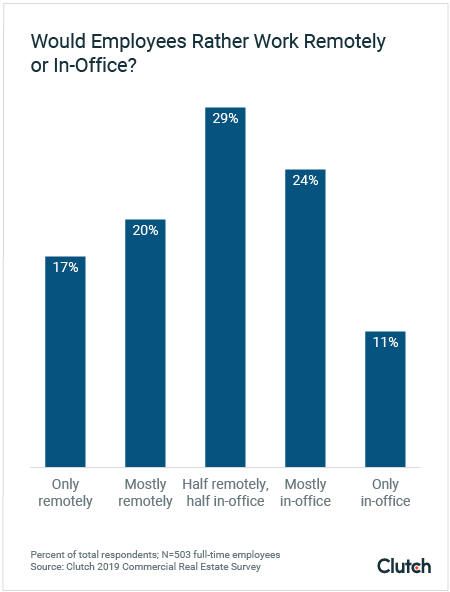
Businesses should create an office space that makes employees look forward to coming to work.
“Making the office a healthy, fun, and social space encourages those who work remotely to want to come into the office,” said Leslie Saul, owner of Leslie Saul & Associates, an architect and interior design firm in Cambridge, Mass.
"Making the office a healthy, fun, and social space encourages those who work remotely to want to come into the office."
Employees value time in-office because it helps them feel like they are part of a company’s culture.
Employers should ensure there is a space for remote workers when they do come to the office.
“Most work-from-home employees I know enjoy knowing there is a spot, even if not a designated spot, for them at the office when needed,” said Bethany Babcock, owner of Foresite Commercial Real Estate, a commercial real estate brokerage firm in Texas. “The alternative sends the message that you belong at home, not here, and this isn’t your office.”
All employees should feel like they belong, whether they’re remote or in-office. Businesses should design an inclusive office space that keeps all employees in mind.
Max Falb, a digital marketing strategist at Fueled, a mobile app design and development company, believes good office space is essential for encouraging remote employees to come into the office.
“The best offices know how to be comfortable and convenient enough where it encourages employees to be in the office during the workday rather than wanting to be at home doing work,” Falb said. “It also allows people to choose how they want to work and interact with people and their environment on a daily basis.”
Employees value their in-office time, and businesses need to make coming to the office enjoyable, not a chore.
Businesses should work with a commercial real estate company to determine the best office space for their employees.
Employees value privacy at the office over shared space, despite an increasing trend toward open floor plans.
More than half of employees (52%) would prefer a private office.
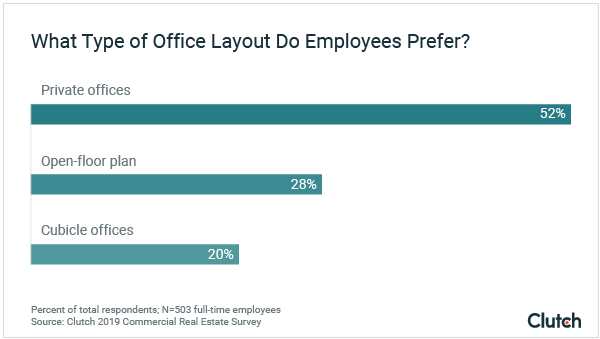
About 28% of employees prefer an open floor plan, and 20% prefer cubicle offices.
An open floor plan is one where employees sit together in a large room. Employers hope to increase collaboration with an open floor plan, but it can also be distracting and frustrating to employees.
“The trend toward open offices continues and is in high demand in spite of employee objections,” Babcock said. “The most common complaint from open office users is frequent interruptions … If a person is in a position that requires focus, it can be irritating and counterproductive.”
Businesses with an open floor office plan may have unsatisfied employees who have trouble getting their work done.
Michael Arnold, a certified speaker, coach, and trainer, works in a cubicle office.
“We are supposed to be able to collaborate, but there is no privacy, so everyone wears headphones, and no one talks,” Arnold said. “Everyone can see anything I bring up on my dual monitors. My current layout has reduced my creativity, privacy, and ability to effectively work.”
"My current layout has reduced my creativity, privacy, and ability to effectively work."
Some employees don’t appreciate the distractions and lack of privacy of an open floor plan or cubicle office space.
Other employees, however, enjoy the collaboration of an open-concept office. JAM Paper & Envelope, an envelope, paper, and office supply e-commerce website, has an open floor office plan, where employees are in a large room.
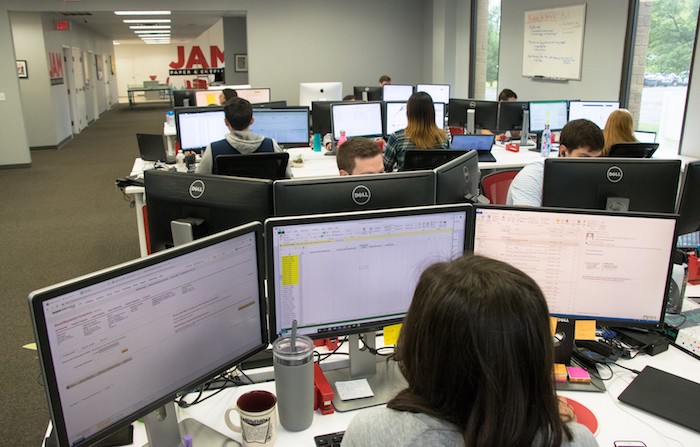
JAM E-Commerce Marketing Assistant Eric Dieterle believes that an open office space allows employees to work together efficiently.
“Working in an open space makes it so easy to communicate and collaborate with the whole department at any given time,” Dieterle said. “We aren’t always waiting around for phone calls or emails to answer problems. We can have actual conversations and get tasks done timely.”
Open floor plans benefit employees whose jobs require interaction with colleagues.
Employees prefer private offices, but businesses are trending toward open floor plans. Businesses should keep employee preferences in mind and offer space that helps employees be most productive.
Businesses should offer a variety of spaces so employees can be as productive as possible.
Nearly three-fourths (74%) of offices have personal spaces for employees, such as individual desks or offices.
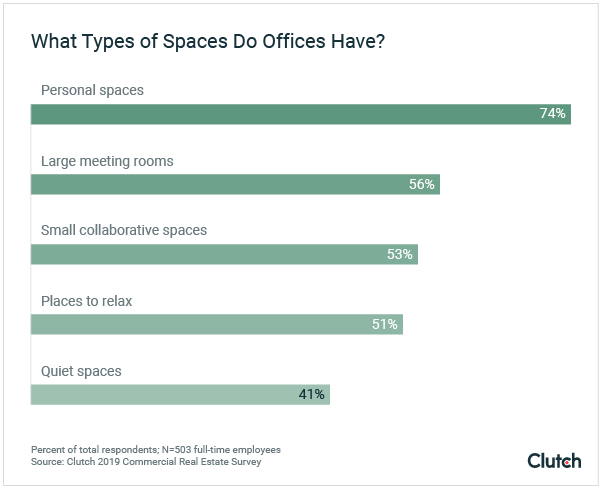
More than half of office spaces have large meeting rooms (56%), collaborative places such as small meeting rooms (53%), and places to relax such as lounges or break rooms (51%). Forty-one percent (41%) of offices have quiet spaces such as call rooms.
A variety of office spaces help employees accomplish different types of work.
For example, a business with an open floor plan should designate a space in the office for one-on-one collaboration or individual work.
“The same benefits of an open plan can be accomplished with a layout that has nooks and crannies built in with work areas that are still open,” Saul said. “This way, one or two people can find a comfortable spot to work on a project as needed.”
Employers should offer spaces for privacy if they have an open floor plan and spaces for collaboration if they have private offices.
Kelsey Davis, content manager at Medicare Plan Finder, appreciates having access to multiple types of spaces.
“I prefer open office layouts that still have access to private spaces for meetings, phone calls, or serious projects,” Davis said. “This creates a comfortable work environment where coworkers can socialize but also allows a bit more privacy when it’s needed.”
The best kind of office is one that offers employees workspaces to accomplish their different tasks successfully, whether that involves quiet and privacy or collaboration and meetings.
Businesses must offer a variety of spaces in their offices, but employees see the most value in their personal spaces.
More than half of employees (53%) say their own space in an office is the most important to them.
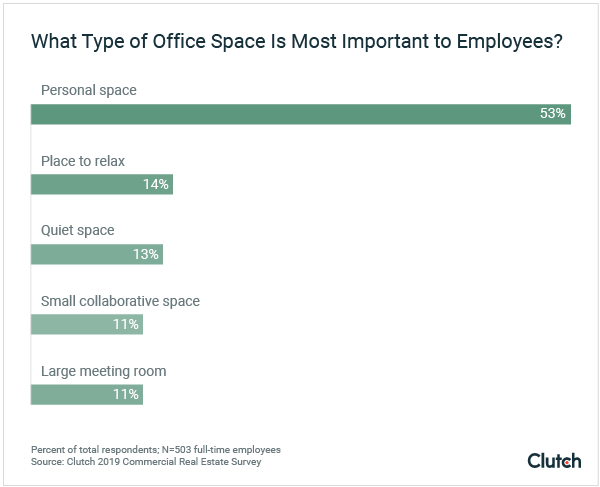
Some employees prefer places to relax (14%), quiet spaces (13%), small collaborative spaces (11%), and large meeting rooms (11%), but personal spaces are by far the most important to most employees.
Personal spaces are where the majority of work gets done.
“[People] prefer to be in their own space where they can … ‘zen’ out into their work,” said Commercial Real Estate Broker Steamer Pease, of Lowerkase Commercial.
Employees can be the most productive in their own space but also value other spaces.
Fueled, for example, has an open floor plan that lets employees work together easily.
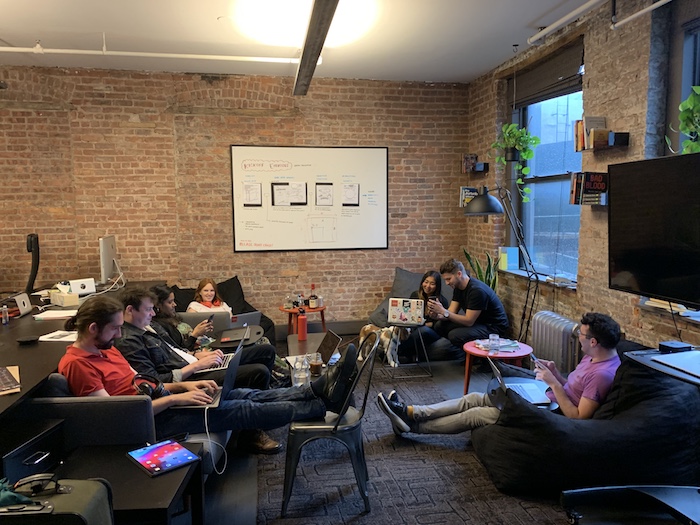
Falb appreciates the collaborative spaces of Fueled’s office but values the personal spaces where he can get his work done quietly.
“For me, [my office] feels comfortable and convenient because of the ability to be easily connected with every part of the team and the whole company but also allows spaces that I can retreat to if I want to do work,” Falb said.
Collaborative spaces are beneficial for working together, but personal spaces help employees accomplish tasks.
Businesses need to value employees’ preference for personal spaces and offer spaces employees can make their own.
Most businesses understand the importance of personal spaces and provide assigned desks, offices, or cubicles for employees to make their own and feel more comfortable at work.
Nearly all employees (98%) have an assigned space at their office.

More than one-third of employees have their own desks (36%) or own offices (36%) assigned to them, and 22% have their own cubicles assigned to them.
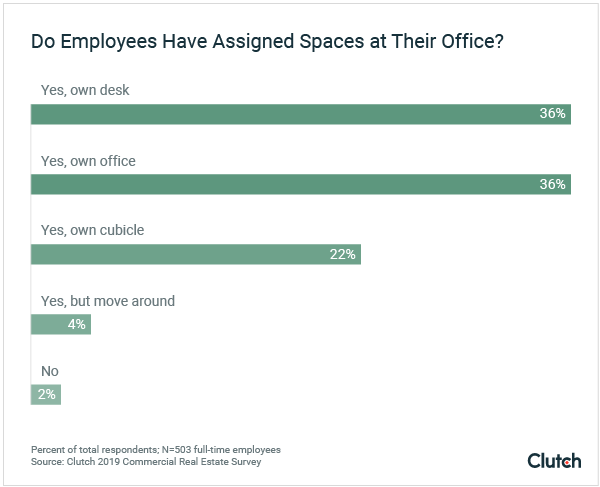
Employees value coming to work to a space that’s “theirs.”
“The value is in having something that’s your own,” Pease said. “It’s your space; you can do with it as you please.”
Employees with their own spot at work feel at ease and more at “home.”
Employees value personal spaces, and businesses should offer assigned office spaces, which employees can personalize and feel more comfortable in.
Employees still value coming to work, even if they work remotely most of the time. Businesses should create an office space in which all employees, both remote and in-office, can feel productive.
Businesses need to offer spaces that help employees accomplish tasks, no matter if they prefer open space or a private office. This includes offering personal spaces, quiet rooms, and collaborative rooms.
Employees appreciate their own spaces at the office, and the best office spaces are the ones where employees can accomplish their tasks efficiently and with as little stress as possible.
Clutch surveyed 503 full-time employees across the U.S. who complete at least the majority of their work for their job in a private office the company leases.
Half of the respondents work in an urban area (50%); 38% work in a suburban area; and 11% work in a rural area.
Sixty-one percent (61%) of respondents are female; 39% are male.
Respondents are from the South (37%), Midwest (22%), West (21%), and Northeast (20%).
Respondents are 18-24 (9%); 25-34 (35%); 35-44 (33%); 45-54 (16%); 55-64 (7%); and 65 and older (1%).
![How to Create a Budget for Commercial Real Estate [With Template]](https://img.shgstatic.com/clutch-static-prod/image/resize/715x400/s3fs-public/article/d084e92eb854adb65c33b5a29b439cc4.png)
![How to Budget for A Business Relocation [With Template]](https://img.shgstatic.com/clutch-static-prod/image/resize/715x400/s3fs-public/article/da44ab3f488dff79138f31d3d3df081c.png)
